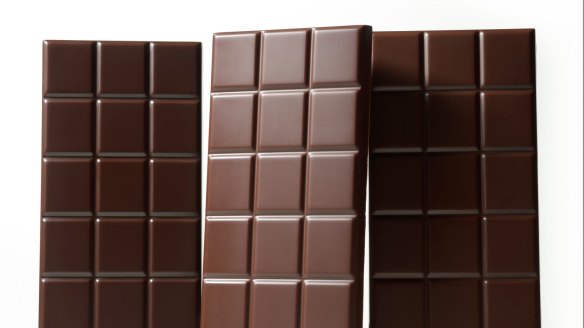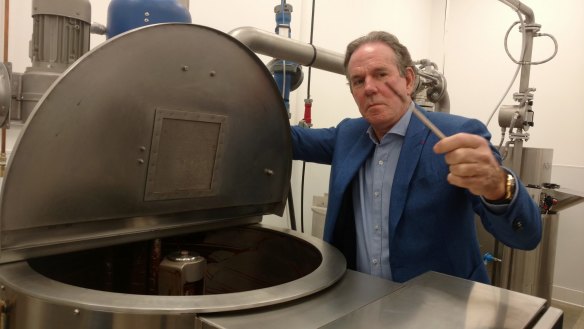Top American chef thinks he perfected chocolate by adding one unusual ingredient

Seven years ago on the back porch of his Californian restaurant The French Laundry, famed chef Thomas Keller kicked back with his longtime friend, Italian olive oil master Armando Manni, and enjoyed a glass of wine. The two toasted their past collaborations and chatted about what could come next.
One of America's most celebrated culinary personalities, Keller had found fame in The French Laundry and Per Se, his pair of three-star Michelin restaurants. He successfully had expanded his restaurant empire from Yountville to Manhattan to Las Vegas. His cookbooks have sold more than 1 million copies.
Manni, a filmmaker turned olive oil maker, had earned his own acclaim with his high-grade Manni Oil, treasured by chefs worldwide, including Keller.

"I said to Armando, 'Let's talk chocolate,'" Keller said. "He comes from olive oil, which is better for you (than other fats). Chocolate also has antioxidants. (I wondered): Is there a way to combine olive oil and chocolate to make something delicious that was good for you, too?"
Manni agreed that it was an intriguing question.
That question led to the creation of a luxury chocolate that soon will be available to more chocolate lovers. Keller's joint venture with Manni - K + M Extravirgin Chocolate - has expanded its line of fair trade, single origin chocolates as well as its distribution beyond wine country.
Olive oil ... changes the mouthfeel. It's very velvety, luxurious, especially in dark chocolates.
In Napa, the two friends founded K + M in 2012 with the intention of using Manni Oil to make the "perfect chocolate bar", Keller said. Extra virgin olive oil would replace the traditional cocoa butter - the fat found in cocoa beans - in the finished chocolate.
When they started the project, olive oil in dark chocolate was unheard of in America, Keller said. It's still a novel idea, however some chocolate makers and pastry chefs are beginning to experiment with their own recipes and methods.
Keller wanted more than a straight switch; he wanted more antioxidants, too. While cocoa is naturally high in heart-healthy antioxidants, about 60 per cent of those compounds are lost in traditional processing into chocolate, experts say.
Keller and his team worked with the University of Florence in Italy to develop a way to make chocolate with olive oil while preserving both ingredients' purported health benefits.
Such a marriage appears to have benefits. Research in Italy by the University of Pisa linked dark chocolate enriched with olive oil to reduced risks of cardiovascular disease.
Several US studies have pointed to the health benefits of antioxidants in dark chocolate. Keller's company claims testing of K + M's dark chocolate showed that it contains as much as three times the antioxidant level as other luxury dark chocolates.
Those antioxidants also are tied to cocoa's flavour and aroma. Preserving more of them boosts the final chocolate's taste.
"Our goal was to develop the perfect chocolate," Manni told Forbes magazine last year.
In 2016, the company sold its first dark chocolates, a trio of bars offered exclusively through Williams Sonoma in the US. In September, it introduced its first milk chocolate and a combination "dark milk". (The chocolate is also for sale in Britain and Canada but is unavailable in Australia for now.)
Now, the company features eight variations on its chocolate. In addition, the company started offering its bars at many US gourmet stores as well as online.
Although pricey - $US14.95 ($19.90) for a 70-gram bar - it's chocolate done in a new way, Keller said.
Why olive oil?
Last week, Keller invited a handful of reporters to his Napa chocolate factory to learn about its method.
"Our goal wasn't to build a chocolate factory," Keller said. "But we realised our idea needed proprietarised equipment. We couldn't just buy machines to make this chocolate."
Instead of traditional cocoa butter, a tiny amount of extra virgin olive oil is added to each chocolate bar. The oil's grassy flavour is barely perceptible. The oil helps preserve and accent the natural richness and depth of flavour found in the cocoa beans.
"Olive oil ... changes the mouthfeel," said head chocolatier Chi Bui. "It's very velvety, luxurious, especially in dark chocolates."
Because olive oil is a liquid, these chocolates also melt at much lower temperatures.
Bui personally sources the beans, oversees roasting and develops the final flavour profiles for each product.
How it's made
Cocoa beans go through several steps before becoming chocolate. The beans are fermented and dried at their source farms in Nicaragua, Peru, Ecuador and Madagascar. The beans are then roasted at the Napa factory.
"We roast the beans differently to preserve as much of the antioxidants as possible," Bui says.
The roasting room, which processes more than 400 pounds of beans a day, provides a mix of heady scents.
"During roasting, it smells like cider vinegar; a little bitter, a little sweet," Bui said. "If the beans were fermented improperly, it smells terrible. But after roasting, the beans finally smell like chocolate."
After roasting, the beans are crushed, exposing the flavourful nibs. The papery shells are removed and the nibs crushed into crumbs. Sugar is added and the mixture is ground into a micro-fine liquid for conching, a slow process where the chocolate is stirred by machine for many hours.
Like wine, these chocolates are aged, she said. "But it's much faster; three to six months," she said.
The chocolate rests in chilled rooms to further develop its flavour before it's made into bars.
Those flavours are distinctive and complex. The Ecuadorian "dark milk" tastes of mango and molasses while its Nicaraguan counterpart has silky black currant notes. The Peruvian dark chocolate combines orange blossom and quince notes, and the Madagascar beans boast bright citrus and caramel.
"For a chocolate maker, this project is the most intriguing," Bui said. "It's really pioneering. The philosophy behind it is pretty simple: Make chocolate that tastes good that's also good for you. But it's a tricky nexus between the two."
Tribune News Service
- More:
- Food